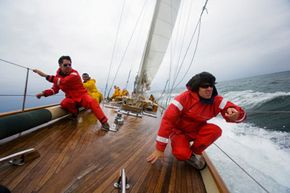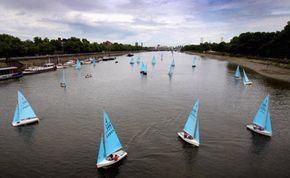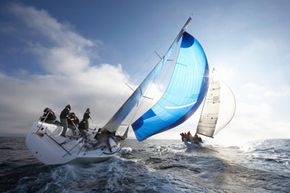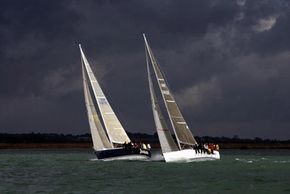If you're looking for a little fun and some high-seas adventure, there are some popular types of recreational sailing that may suit you. If you're looking for something a little different, we have a few unconventional suggestions, too.
If you're a sailing novice, you might want to start out with small sailboats like dinghies, daysailers and small keelboats. They're easy to maneuver, are usually less than 25 feet in length. These can be sailed by an individual (solo sailing) or with one crewmember [source: U.S. Sailing]. Some sailors begin with small sailboats and continue adventuring this way even as they become experts. Dinghies are fun and lightweight -- they're used by college racing teams and in the Olympics, and they're perfect for weekend warriors.
Some adventurers, though, take their sailing hobby to a whole new level and go cruising. Cruising isn't a just a hobby; it's a lifestyle. When you hear about someone who is sailing around the world, they're cruising. Sailors who choose cruising live on their sailboats and travel for extended periods of time. Their vessels range from basic keelboats to large, multi-hull cruising yachts. Most boats intended for cruising have many of the comforts of home below deck, and depending on their size, may include beds, bathrooms, kitchen facilities and even entertainment systems.
For those who want the adventure or relaxation of sailing without the work, boats can be chartered with skippers, and yachts can be chartered with crews. Two popular types of family-friendly chartered sailing adventures are sunset cruises and Caribbean sailing vacations. Sunset cruises are leisurely sailing experiences and are typically chartered by small groups looking to relax. If sailing in the Caribbean like the rich and famous sounds more like your style, boats (with or without hired crews) may be chartered through travel agencies. Some popular island destinations for Caribbean sailors include the Virgin Islands, Antigua, St. Barts, St. Martin and Grenada.
For sailors who wish to break outside of the norm, some resorts offer nude sailing daytrips as well as multi-day island-hopping cruise packages. (Just remember to pack extra sunscreen).
If, however, you're looking for an alternative to the sun, sand and waves scene, ice sailing -- also called ice boating, ice yachting, ice surfing and hard water sailing -- turns sailing into a winter sport. Ice sailing began in the Netherlands in the 1800s as a way to traverse frozen lakes during winter, and has been growing in popularity as a recreational sport since the introduction of ice sailing boats in the 1930s.
Did you know sailboats can't be taken directly into the wind? In the next section, learn the five essentials of sailing.




